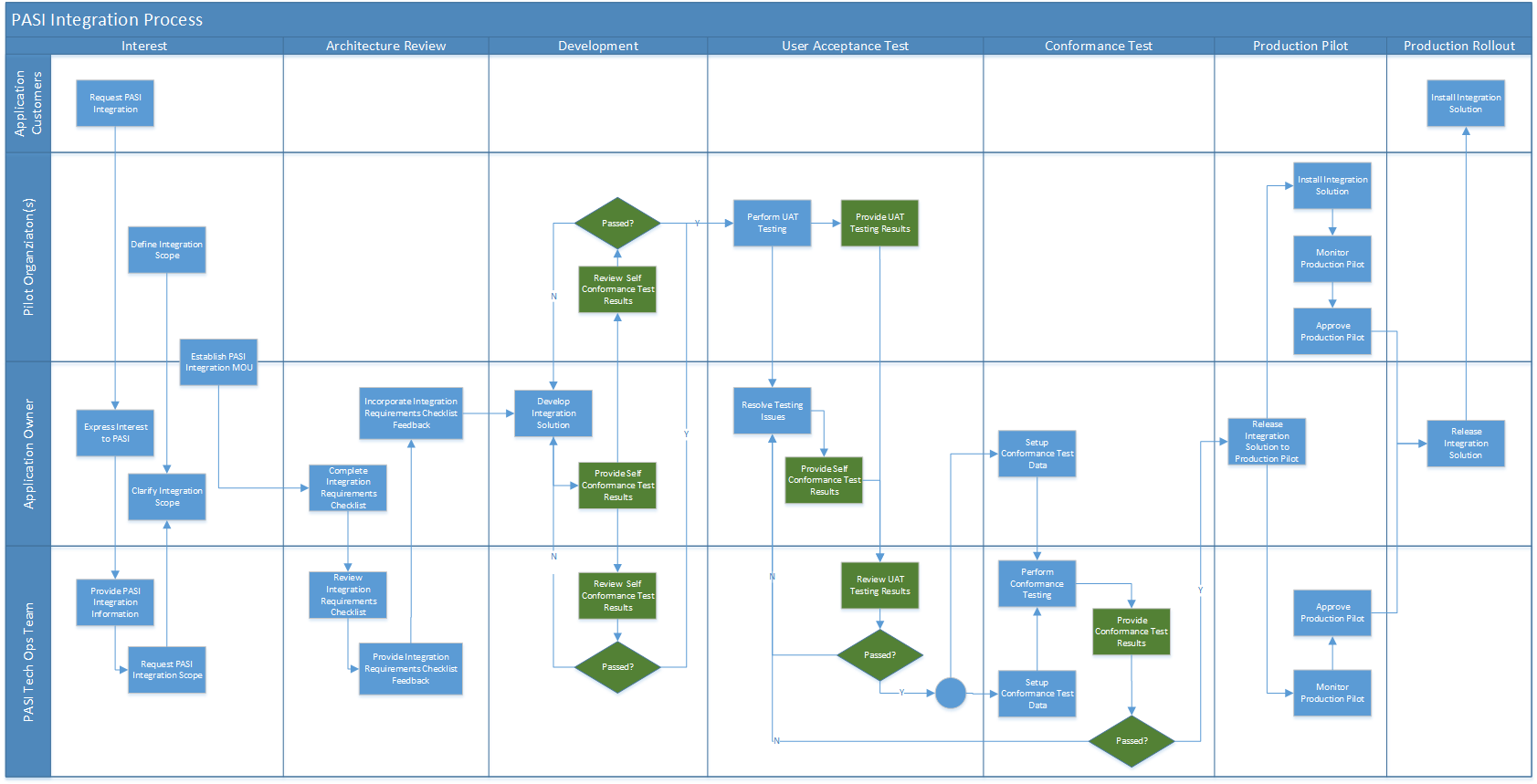Table of Contents
Integration Process
Under Construction
This process outlines the general process followed when a system wishes to integrate with PASI.
This process is organized into 7 phases:
Interest
The Interest phase is the initial phase of integration with PASI. This phase is initiated by the software product owner contacting the PASI team to discuss integration. Typically during this phase, the software product owner discusses the integration with their clients and with PASI to ensure all parties understand the scope of the integration.
There are no formal interactions at this point, but generally includes a meeting or two.
Memorandum of Understanding
Before proceeding into the Architecture Review phase, the PASI team expects to see a copy of an MOU that has been established between the software product owner and at least one pilot organization. This MOU will ensure that there is a commitment between the pilot organization and the software product owner in terms of developing, testing, and implementing the integration with PASI.
Without an MOU, the PASI Team will not support the integration of a software product and PASI.
Architecture Review
Once the scope of the integration has been confirmed, the PASI team will provide an Integration Requirements Checklist for the software product owner to complete. This checklist is intended to highlight various aspects of the integration with PASI that needs to be considered by the software product owner.
The software product owner will forward the completed checklist to the PASI Team for review. Feedback will be provided and discussed, and if required, the software product owner will provide an updated checklist incorporating the feedback provided.
Development
Once the architecture of the solution is reviewed and accepted, the software product owner can complete their development of their integrated solution.
During development the PASI Team encourages the software product owner to have an open dialog to discuss progress, challenges, issues, etc. in order to assist the software product owner develop a working solution.
As part of this development phase, the software product owner is expected to review and execute a set of conformance test cases provided by the PASI team related to the scope of integration. It is expected that all conformance test cases are successfully executed before proceeding to the next phase. The software product owner must complete the Conformance Testing Status Checklist and provide a copy of it to both the pilot organization and the PASI Team as a check and balance to confirm the software produce owner has completed a self conformance test.
Both parties must agree that the conformance testing was success before proceeding to the next phase. If any issues are raised, it is expected that the software product owner will resolve the issues, and re-execute the appropriate conformance testing.
Integration User Acceptance Testing
A key part of the Integration Process is User Acceptance Testing (UAT) performed by the pilot organization. During this phase, the pilot organization is expected to confirm that the solution meets their business requirements.
In addition, the pilot organization is expected to execute a set of conformance test cases provided by the PASI team. These test cases are intended to confirm that business processes that involve integration with PASI meet business requirements - ultimately ensuring the student data in PASI and the integrated solution are correctly managed throughout the processes.
If any issues are identified during this UAT phase, it is expected that the software product owner will address the issues, and if needed redo conformance test cases that are impacted by the changes. Once all UAT issues have been addressed, the pilot organization will forward the UAT results to the PASI Team. The PASI Team will review the results and if no issues are identified, will proceed to the Conformance Testing phase.
Conformance Testing
After UAT is complete, the PASI Team will perform conformance testing. During this phase, the PASI team will execute a subset of the conformance tests previously provided to the software product owner. This phase provides the PASI team an assurance that the software has been developed in accordance with the architectural designs previously made, and is free of defects that will negatively impact:
- The stability of the PASI system,
- The integration with other systems,
- The integrity of the Student data captured across integrated systems.
It is expected that any issues found during this phase are addressed by the software product owner, and confirmed via UAT with the pilot organization.
Once completed, the PASI Team will provide the conformance test results (Conformance Test Status Checklist) back to the software product owner and the pilot organization, along with a recommendation that the software product can be release to the pilot organizations for use in production.
Production Pilot
During the Production Pilot phase, the pilot organization(s) implements the integrated solution and uses the solution to do their day-to-day business. Once satisfied, the pilot organization(s) will provide the PASI Team production pilot signoff indicating the integration solution meets their business needs and updates PASI correctly.
During this phase, the PASI Team will also monitor the integration to confirm the solution is working as expected. Once the PASI Team is satisfied the solution is working as expected and has received the pilot organization production pilot signoff, the PASI Team will approve a full release of the integrated solution to the customers of the software product owner.
Rollout
This final Rollout phase, is when the remaining customers of the integrated software solution implement the product in their environments. At this point, the integration process is deemed complete.

